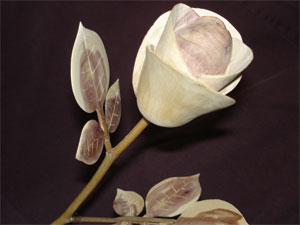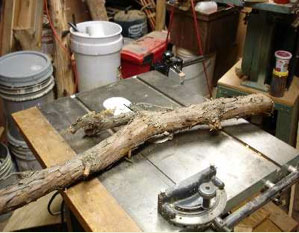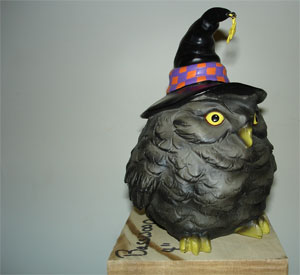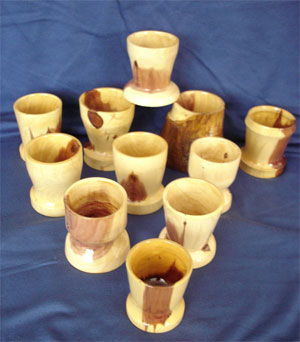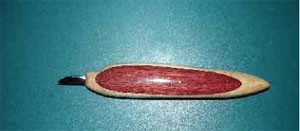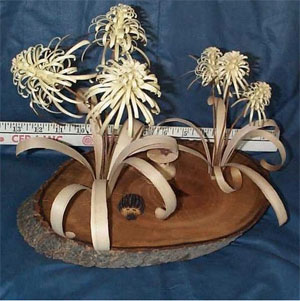
Riley Grotts says he “can’t remember when I wasn’t” a woodworker. As a child of a military parent, the only place that truly seemed like home during his childhood was in Oklahoma, where his master carpenter grandfather had a garage workshop with “a huge pile of sawdust and all the trimmings.”
From that shop, Riley said, “I nailed more little boats together and floated them down the creek than even most boat builders ever put together in a lifetime.”
He describes his sewing skills, however, as “minimal,” which is how he ended up portraying a woodcarving character for several years at renaissance fairs. Around 2001, after helping with site work on the then-new Kansas City (Missouri) Renaissance Festival, Riley decided he wanted to play a character. The need was for street characters, and the easiest costume to make was a “sack dress” — which became a cassock for “Brother William.”
As part of his character portrayal, he began carrying a carving knife hung from his belt and would “pick up a stick off the ground and carve a flower and hand it to people.” Eventually, he made some adaptations — the knife at the belt was “too close to little hands,” and kids would be handing him a stick they’d found — after pulling off the poison ivy leaves. Riley as Brother William eventually made a knife holder in the end of his staff, with a little hole for a drill bit, and carried his own supply of sticks in a quiver.
“Every once in a while, a little kid would say, very quietly, ‘I wish I could do that.'” With the parents’ permission, Riley would take the child aside. “Rule Number One is ‘always think about where the knife is going to go if you slip,'” he said. “I gave them pointers. Then we’d do one with them holding onto my hands, one with me holding onto their hands, and they’d do one.
“One of my proudest moments was with a little girl who was badly burned in her early years. I had talked to her mom and asked if a carving knife would be OK.” On the family’s next visit, Riley had made a carving knife slightly modified to fit the girl’s hand, with a pouch from a leatherworker. “She sat down and promptly made a flower. The mom was pleased as punch, because she needed to exercise. This was something that she wanted to do that accomplished something she had to do. It was a win-win all the way around.”
Riley no longer does renaissance festivals : “I started out in the 70s as an auto and diesel mechanic and broke enough fingers that they’re stiff and sore all the time, and then spent 30 weekends a year from 9 a.m. to 7 p.m. carving flowers; it pretty much tore up my hands,” he said. “I’m paying for it now, but I wouldn’t have it any other way.”
And, that doesn’t mean he’s not doing woodworking. His current project, for example, involves trying to figure out how to rebuild a sewing machine cabinet with drawers shaped like partial ovals. “It’s an interesting thought process that’s been going on for about two or three months.”
In general, Riley says, “I plan things in my head for a long time before they ever get going.” And then, once it’s built, it’s unlikely he’d build that project again. “I’ll do it until I get it right, but I won’t do a second once I get it right,” he said. “I rarely do pairs. If I do, I’ll do drawings and I’ll make a piece and a silhouette, and I’ll give the person both pieces and the piece of cardboard with the drawing.”
He did make several cedar sake cups for his wife to present to teachers in Japan as part of an exchange program — but at the time, he was also turning 2″-diameter plates for a friend who likes to collect dollhouse-sized items.
Riley has been turning for quite some time: his very first homemade tool was a lathe he created in the 1960s with the motor and turntable from a record player he purchased at an auction. He presented that lathe to his parents as a Christmas gift; the following year, on Father’s Day, his dad went out and bought a commercially manufactured wood lathe. “We assembled it, bought a motor, set it up on a bench in the garage, and then he said, ‘OK, I’m done playing with it,’ and walked off and left it to me,” Riley said.
He has also done quite a bit of carving — in addition to the flowers done as Brother William, he went through a series of homemade carving knives for a while. He would get a finished product, and then, “I would try it, and it wouldn’t be quite right. I’d take it to the woodcarvers’ group and somebody would say, ‘That’s pretty nice,’ and I’d say, ‘OK, it’s yours.’ I gave away a lot that didn’t quite fit me, but if they fit somebody else, by golly, I’m better off letting them have it.”
Riley’s projects have been made out of a variety of wood. “I love sycamore because of the way it smells; it has fond memories for me,” he said. “In Oklahoma below the dam where I learned to swim, it smelled like that all the time.” Other than that, however, he’ll pick “anything that has wild grain and that looks fun. If it looks good, I’m going to stick it in a corner, and it’ll get used for something.”
